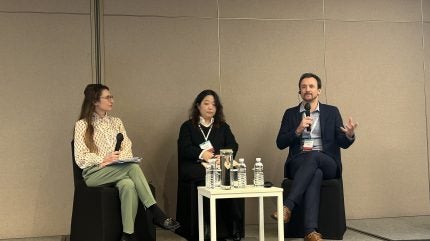
Placing emphasis on supply chains before initiating a clinical trial can help create protocols that are robust against delays, unlike current approaches that mainly rely on being reactive to problems that arise, according to experts.
“[Supply chains] are often forgotten, being the very last cog of clinical research. That leaves clinical supply chains with a lot of constraints: the protocol, the systems, and manufacturing strategy,” said Amaury Jeandrain, clinical supply strategy adviser at N-Side.
Jeandrain added that because clinical supply is not involved in strategic decisions, these become a constraint along the chain.
Jeandrain was speaking as part of a panel discussion at the Outsourcing in Clinical Trials and Clinical Trial Supply East Asia held in Seoul, South Korea, from 3 to 4 December.
A report by GlobalData demonstrates that supply chain disruptions have become worse and more frequent over the past decade. Reworking supply chains is complex and expensive, with no quick fixes.
Hye Jung Yang, clinical project manager at MedPacto and who was also on the panel, echoed the preventative standpoint, explaining that mitigating risk should be conducted before the trial has commenced. Using data to predict issues is much easier than reacting to them once they crop up, she added.

US Tariffs are shifting - will you react or anticipate?
Don’t let policy changes catch you off guard. Stay proactive with real-time data and expert analysis.
By GlobalDataOne example brought up in the discussion was clinical trials using comparators. Unlike standard-of-care, which can often be sourced locally, supplying comparator medicines is complex and subject to delays. This includes packaging and labelling, adding time to trial timelines which are often constrained.
Jeandrain said that placing emphasis on supply chains earlier and building trials around them can make a more meaningful impact.
“If supply chain could influence protocol design, we could have protocols that are supply chain friendly,” he said.
Jeandrain explained that reducing drug waste can have a strong impact on supply chain costs, mediated via supply chain-friendly protocols.
An area that is harder to predict, the panel agreed, is geopolitical issues. Indeed, Seoul itself was thrust into one on the first night of the conference after President Yoon Suk Yeol declared martial law. Though swiftly U-turning on his decision, shares in many South Korean pharmaceutical companies dropped overnight.
Jeandrain places supply chain disruptions into two categories – foreseeable and unforeseeable. Foreseeable ones such as small delays in shipments and temperature excursions should be planned for, he says. But the unforeseeable disruptions, including geopolitical disruptions, quality issues, and comparator shortages, are “a lot more complicated”.
“[Unforeseeable disruptions] tend to create massive shortages in the entire clinical trial’s supply chain. They not only put patients at risk but the trial itself,” Jeandrain said.
“To solve them, it’s important to list your mitigation options, of which hundreds exist, understand whether these solutions are implementable, at what cost, and prioritise them. But also to understand whether these solutions will actually solve the problem. You do not want to slow down recruitment, or close sites if a combination of other solutions will solve the problem.”



